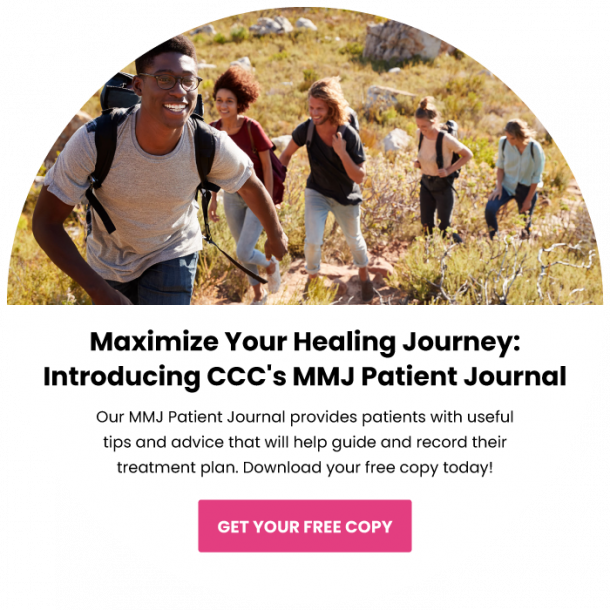The cannabis plant contains a number of compounds with research-backed benefits for cancer patients.
The science-based case that it is a safe and effective medicine will be made below, with plenty of links to double-blind studies, authoritative sources, and leading experts. The takeaway being that the plant and preparations derived from it can provide relief of cancer-related symptoms like pain, nausea, and inflammation. Some research has even shown that some cannabis compounds may slow cancer growth and shrink tumors.
Cannabis can also elevate your mood at critical moments, and even help you psychologically come to grips with the difficult times ahead. This is no small thing. Many of the medicines you will be prescribed, and procedures you will undergo—helpful as they may be—will leave you feeling depleted (to say the least).
Cannabis is restorative—to body and soul.
To laugh, to escape from pain and anxiety, to step outside one’s self and experience a moment of peace, or bliss, or both—what could be more healing? Now, I don’t have any studies to back up this particular claim, but I have seen it firsthand countless times in my 15 years of meeting cancer patients and writing about their relationship with medical cannabis. And that includes both people who had a lot of experience with cannabis before they got cancer and those who’d never even considered trying it before.
Now, it’s perfectly understandable if, after a century of anti-cannabis government propaganda, you’re skeptical about such anecdotal claims. But please don’t let that prevent you from further researching the subject. I believe any cancer patient who takes the time to review the evidence with an open mind will conclude that cannabis is an option worth trying, whether you’re undergoing chemotherapy or not.
The Case for Medical Cannabis
Cannabis remains illegal even for medicinal use in many places around the world. This forces countless cancer patients every year to resort to the underground market, where they risk arrest for simply possessing a small amount of plant matter. Beyond that, it’s also important to understand that cannabis itself is not harmless.
But neither is water, if you drink too much.
So when we talk about the potential risks of cannabis, we need to talk not about it being “safe” or “dangerous,” but in terms of “relative harm.”
When it comes to cancer specifically, there’s been a number of landmark studies proving the safety and efficacy of cannabis.
The first ever study to show that cannabis exhibits anti-tumor properties was originally designed to demonstrate the plant’s dangers, specifically harm to the immune system. Funded by a grant from the American Cancer Society, research published in 1974 in The Journal of the National Cancer Institute showed that mice who had tumors surgically implanted and were then “treated for 20 consecutive days with THC” had reduced primary tumor size.
The government immediately pushed the offending study down the memory hole, and pushed on with the War on Cannabis, but three decades later, Dr. Manuel Guzman, professor of biochemistry at the University of Madrid, managed to follow up on the original 1974 experiments, with similar results. In the March 2000 issue of the journal Nature Medicine, Guzman reported that cannabinoids (like THC) not only shrink cancerous tumors in mice, they do so without damaging surrounding tissues.
A year later, a study published in the New England Journal of Medicine for the first time demonstrated the efficacy of THC for nausea and vomiting associated with chemotherapy.
“A day doesn’t go by where I don’t see a cancer patient who has nausea, vomiting, loss of appetite, pain, depression, and insomnia,” Dr. Donald Abrams, chief of hematology-oncology at San Francisco General Hospital and a professor of clinical medicine at the University of California, San Francisco told Newsweek for a 2013 article headlined Marijuana Is a Wonder Drug When It Comes to the Horrors of Chemo. “Cannabis is the only anti-nausea medicine that increases appetite.”
More recently, in 2017, the International Journal of Oncology published a report showing that cannabinoids produced naturally in a cannabis plant possess anti-cancer activity whether used alone or in conjunction with chemotherapy. While according to research by Yale Cancer Center, a majority of pediatric cancer providers now endorse the use of medical cannabis for children with advanced cancer.
Talking With Your Doctor
Many physicians and medical professionals (including cancer specialists) remain wholly unaware of the many ways cannabis can support those going through cancer treatments, so it’s important to show up to every appointment armed with as much information as possible. But you should be cautious as well, particularly if you live in a place where medical cannabis is not legal, and admitting to using cannabis could potentially lead to legal trouble, refusal of medical care, or problems with your insurance coverage.
How to Obtain Medical Cannabis
If you live in a place with either legal cannabis or legal medical cannabis, you should have no problem accessing what you need through a dispensary. There may be some legal hoops to jump through to sign up for your state’s medical cannabis program, but as a cancer patient you most certainly qualify.
The Leafly app can help you locate the best dispensary within a reasonable distance from where you live, and then you can search their menu online to make sure they’ve got the specific products you’re looking for before you pay them a visit.
Everything you find on a dispensary shelf should be lab tested for purity and potency, but it’s still a good idea to seek out cannabis grown without the use of chemical pesticides and fertilizers. Federal law prohibits using the word “organic” when it comes to cannabis, but there are third party certifications that mean the same thing, and certain companies only work with growers using organic methods.
If you live in a place without legal medical cannabis, you’ll have to first carefully weigh the potential benefits of having this medicine in your life against the risk of legal consequences.
The medical cannabis movement has been built on civil disobedience, and the foundational belief that any law preventing the seriously ill from accessing a proven medicinal plant should be actively subverted. So feel no shame, and don’t be afraid to ask for help. Think of a person in your life whom you trust, and who already has access to cannabis, and let them in on your situation.
Dosing Medical Cannabis
When it comes to identifying your ideal dosage, the most important thing to know is that you should start with very small amounts of cannabis and slowly increase them until you find what works best for you, without going over the dose.
It’s also vital to understand that different delivery methods will produce vastly different effects, including how quickly they onset and how long they last. Inhalation will have you feeling relief in less than a minute. Just start with a puff or two, see what happens in a couple of minutes, and then inhale more as needed.
Meanwhile, edibles can take up to 90 minutes to onset, and last for up to eight hours. That makes them ideal for long-term relief, but you run the risk of eating too much before you start to feel the effects. So until you get the hang of it, stick to low-dose edibles (five or ten milligrams of THC) and then slowly up your dose as needed—always waiting at least 2 hours between doses to account for the lag time.
Incorporating CBD-rich cannabis products into your regiment gives you access to another therapeutic cannabinoid, one that is also shown to reduce anxiety induced by larger doses of THC. (Note: small doses of CBD can enhance THC’s intoxicating properties, but large doses appear to counteract unwanted side effects.)
Be sure to remain well hydrated at all times, and ideally share the experience with a friend. Definitely stay home the first few times you use cannabis, particularly as you get used to the experience and while experimenting to find your optimal dose.
Source
Dr. Manuel Guzman, professor of biochemistry at the University of Madrid, managed to follow up on the original 1974 experiments, with similar results. In the March 2000 issue of the journal Nature Medicine, Guzman reported that cannabinoids (like THC) not only shrink cancerous tumors in mice, they do so without damaging surrounding tissues.


